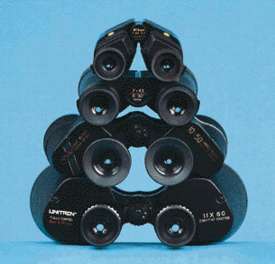
The astronomical performance of binoculars can be rated at a glance. Just multiply the power (the first of the two numbers in a designation like '8 x 50') by the aperture (the second number, given in millimeters). The product is the visibility factor, according to Roy L. Bishop.
Sky and Telescope/Chuck Baker
When you buy binoculars, you should check their performance at the store or, if you mail-order them, as soon as they arrive. Here are a few tests to help you judge binocular quality and performance.
1. Grasp a binocular barrel in each hand and move the halves back and forth. The hinge should work smoothly without any play. So should the focusing mechanism. In center-focus binoculars, the bar joining the eyepieces should not rock back and forth as you focus them.
2. Check for dirt, mildew, fingerprints, or chips on the optical surfaces.
The two circles of light that appear to float within this binocular's eye lenses are exit pupils. Better binoculars have sharp, round exit pupils like these.
SkyWatch/ Craig Michael Utter
3. Check the exit pupils by holding the binoculars a foot or so in front of you and pointing them at a blank indoor wall or the bright sky (but not at the Sun). The exit pupils in the best binoculars are uniformly bright and have round edges surrounded by darkness.
4. Look at some detailed objects through sharply focused binoculars. If you have astigmatism, leave your glasses on. If you are near- or far-sighted, take your glasses off and refocus. Adjust the barrels to match the separation between your eyes. You should see a single image comfortably. If you see a double image, or if your eyes feel uncomfortable as they "splice" the image together, you shouldn't buy those binoculars.
5. When given the choice, most observers prefer large fields of view. However, in some of the widest-field binoculars the edges of the field are conspicuously distorted. Sweep the field across something straight, like a door frame or a telephone pole, to see how much the line bows near the edge of the field. Even the best low-power binoculars will have some degree of distortion, so it's best to compare potential purchases side by side.
6. Look at a high-contrast object such as a tree limb or the dark edge of a building against the daytime sky. Do you see yellow-green or violet fringes of light along the edges of the object? These colors should be greatly diminished across at least the middle portion of the field of view.
7. The best test of optical quality is a real star. Focus in on a bright one. Does it appear sharp and pointlike, as it should? Does it stay sharp as you move the binoculars so the star appears at the edge of the field of view? Does the star stay round as you move it in and out of focus?
Once you find binoculars you like, have fun — they'll provide you with a lifetime of celestial exploring. And remember that for thousands of years astronomers used the 1x7 binoculars they were born with to see the sky — their eyes!
 0
0
Comments
You must be logged in to post a comment.